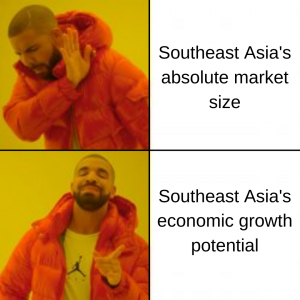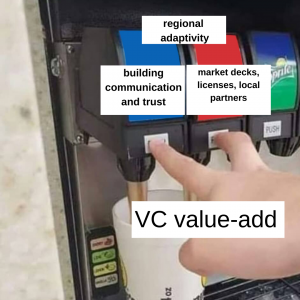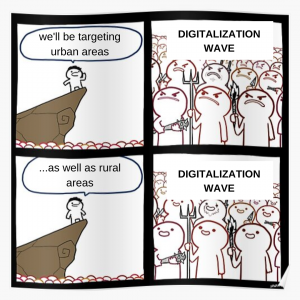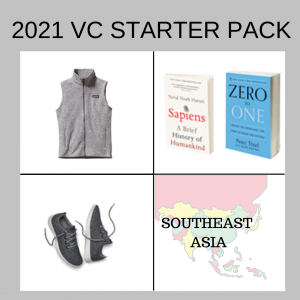Highlights
- In spite of relatively smaller market size and thinner margins of hot verticals, the scale of companies and growth potential of digital markets in the region are what attracts investors.
- Forming communities is key to supporting founders in their regional growth.
- As the region’s markets support digitalization beyond urban areas and the formation of national champions, the next generation of decacorns will likely come from enablers of this nationalization and consolidation across key verticals.
- As the region’s venture-backed tech companies get more validation from the public markets, the balance of power has shifted between investors and founders and investors will be investing more in developing their brand and positioning in the market.
- When it comes to investing in early-stage companies, spotting organic growth and raw energy for regional growth from founders is important.
When we talk about increasing interest in Southeast Asia’s tech ecosystem, the headlines often cover landmark deals, global PE and VC funds (or more recently SPACs) raised for these emerging markets, or the gold rush of family offices and HNWIs setting up shop in the region. But accompanying the capital influx is a talent influx as well that isn’t discussed as much. And when we talk about the talent influx, it also isn’t limited to senior executives, seasoned engineers from the Valley, or returnee founders.
Even enterprising undergraduates still in university are looking to Southeast Asia as a potential destination for their careers or ventures after graduation. That much was clear from the chat Yinglan had with Stanford undergraduates on Southeast Asia’s startup ecosystem, alongside fellow Southeast Asia OG early-stage investors Vinnie Lauria from Golden Gate Ventures and 500 Startups’ Vishal Harnal.
As with any of the panel discussions we are able to join, we’ve taken down some of the key highlights from the discussion to share with readers of the Insignia Business Review, specifically for those interested in investing in the region.
Investing in the region’s localized, fast growth
One of the interesting things about Southeast Asia as a rapidly emerging tech ecosystem is that the focus of venture capital in the region in terms of what companies to invest in has largely been around inherently local, livelihood problems, as opposed to global or more technology-based issues. While the latter normally entails innovating around core and deep technologies (e.g. chips, algorithms, and hardware), the former is more about innovating distribution, user experiences, and pricing.
So while investing in the former means investing in relatively thinner margins — also considering the arbitrage in goods across markets — the rapid middle-class income growth of countries in Southeast Asia made up for the thin margins in terms of scale.
And so investors in the region are attracted less by the absolute market size of Southeast Asia, and more the growth potential of the region. Economic growth in the region is able to meet global investors’ expectations, even if the companies are not necessarily going for the global market. This means that it’s important to invest as early as possible in the region. And early here is relative with just how many people are coming on the internet year-on-year in the region, and new opportunities for digitalization emerging especially out of the pandemic. And the rise in digitally-savvy consumers will continue to be Southeast Asia’s growth engine for the next decade.
Another important reason for the focus on ASEAN-first solutions to local problems is the belief in the ability of these companies to build strong localization moats that could withstand even the threats of global competitors. One go-to example is Uber, which incidentally realized relatively huge returns from the SPAC merger of its former regional competitor Grab in the past month.
Uber’s approach of selling an “exclusive, chauffeur service” in the region was foreign to a middle class who were well accustomed to commuting and taking taxis. This opened up the market for a player like Grab that brought ride-hailing to taxi services. Indonesia’s Go-Jek took it a step further and tapped into the fact many in Indonesia commuted or rode two-wheeled vehicles (ojeks) over four-wheeled ones (taxis).
At the same time, while there’s certainly an onus to build ASEAN-first solutions and avoid clones or even mutants in some cases, many successful business models and market disruptions in the region are informed by learnings from other markets. And being attuned to these learnings is an important value-add for venture capitalists in Southeast Asia.
Investing in regional adaptivity muscle
Apart from being able to translate learnings from other markets into Southeast Asia, venture capitalists in the region also seek to support their portfolio companies in crossing market lines.
But moving from market to market is not just about getting the right licenses, finding the right local partners, and figuring out the right go-to-market strategy. There’s also a level of non-tangible nuance needed to navigate each market in the region, that involves building communication and trust.
And this nuance isn’t easily covered by market decks and strategy meetings. VC firms covering the region have found it useful to unlock these barriers by fostering communities amongst their portfolio founders from across various markets.
This regional adaptivity is not only an important asset in a venture capitalist’s toolkit to support portfolio companies, but also a crucial factor to evaluate which investments are worth making. Startups with a mindset to go regional from day one are better suited to build their adaptivity muscle when it comes to expanding from market to market.
Investing in national and regional decacorn enablers
One of the key factors that enabled Southeast Asia’s current generation of unicorns and decacorns to scale regionally was the fact that while markets in the region are diverse, many of its urban centers share key similarities. That said, startups in the region have been going beyond targeting urban areas — a trajectory which we’ve covered on Insignia Business Review multiple times. This expansion of startups into second-tier, third-tier cities, and rural areas is part of the bigger picture of markets in Southeast Asia incentivizing the nationalization of tech ecosystems.
What follows will be an oncoming shift in government support across the region from incubation to forming national and regional champions around key verticals, like financial services and ecommerce. The next wave of unicorns and decacorns in the region will thus likely come from enablers of these champions — companies that will focus more on SaaS solutions, IPs, and engineering-heavy innovation, as opposed to consumer apps and marketplaces.
Investing in public market validation
Another shift in Southeast Asia’s tech ecosystem has been the shift in the balance of power between investors and founders. In the region’s early days, with few sizable exits and a high ratio of founders to capital, the onus was on founders to prove themselves. But as the ecosystem has matured and grown, with validation from the public markets and more dry powder in the region, the dynamic has normalized to typical venture capital: the asset class where the assets have the pick of their investors.
Moving forward the region can expect more US$5 billion and US$10 billion outcomes, and with more talented entrepreneurs on the playing field, this makes it an even more attractive landscape for venture capitalists to come in. With the region’s magnetism towards investors as well as competitive VC markets like the US and China driving investors to the region, venture capitalists will have to continually up their positioning to founders moving forward. And to stay ahead, VC firms in the region will likely build upon the a16z approach offering more value-add services like hiring, marketing, and technology support. When it comes to sourcing, the pressure is on maximizing contact time and interface with the best entrepreneurs.
Investing in organic growth and raw energy
And so the question remains — where do early-stage investors find the founders and companies who are tapping into localized, fast growth, have the potential to develop a regional adaptivity muscle, and building the next generation of decacorns and validated successes in the public markets?
There are certainly large verticals and comparables to look at. For those with product and traction on the rails, organic growth is important to ensure ambitious valuations can be followed through. But for pre-product and pre-revenue teams, it’s important to build a strong intuition for that raw energy and unstoppable mentality of building a regional company and owning the market in Southeast Asia. Of course, when it comes to the game of venture capital, a lot of things are out of one’s control, but by taking enough calls and meetings, one can develop the filter and intuition to spot the teams and products behind Southeast Asia’s future.
Paulo Joquiño is a writer and content producer for tech companies, and co-author of the book Navigating ASEANnovation. He is currently Editor of Insignia Business Review, the official publication of Insignia Ventures Partners, and senior content strategist for the venture capital firm, where he started right after graduation. As a university student, he took up multiple work opportunities in content and marketing for startups in Asia. These included interning as an associate at G3 Partners, a Seoul-based marketing agency for tech startups, running tech community engagements at coworking space and business community, ASPACE Philippines, and interning at workspace marketplace FlySpaces. He graduated with a BS Management Engineering at Ateneo de Manila University in 2019.




